Top News
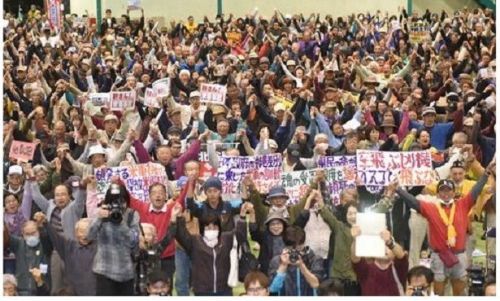
December 16, 2017 Ryukyu Shimpo
On December 15 at the 21st Century Forest Park Gymnasium in Nago City, in observance of the crash of an MV-22 Osprey vertical takeoff and landing aircraft from Futenma Air Station on December 13 last year in Abu, Nago, the All-Okinawa Kaigi (All-Okinawa Coalition) held a gathering to protest these defective aircraft. According to the organizers, people in attendance came from within Okinawa, throughout Japan and abroad, numbering about 3000 in all. Due to repeated U.S. military aircraft accidents following the one in Abu, the Coalition has called for removal of the Osprey, closure of Futenma Air Station, and a halt to flights of all aircraft based at Futenma.
The Coalition harshly criticizes that the continued occurrences of U.S. military aircraft accidents threaten the lives of Okinawan people.
These accidents include the window of a CH-53E helicopter falling onto the grounds of Futenma Daini Elementary and Middle School in Ginowan City, another aircraft part falling onto the roof of a nursery school in Ginowan, and another CH-53E helicopter bursting into flames and making an emergency landing in Takae, Futenma.
A citizen among the participants said, “Without an investigation into the cause [of the accident] the government confirmed resumption of flights; another accident will occur. Each time an accident occurs [the government] repeats its promises of burden reduction and preventative measures, but nothing changes and [Okinawans feel] only resentment.”
Others also spoke angrily of the Japanese government’s compliance with the U.S. military.
Gathering participants made a resolution asking for (1) the prompt removal of the Osprey and a halt to flights of all aircraft based at Futenma Air Station, (2) the withdrawal of the U.S. Marine Corps from Okinawa, the substantial consolidation and reduction of U.S. military bases, and the abandonment of a new base in Henoko or relocation of Futenma Air Station within Okinawa but also the closure and removal of Futenma, (3) and a drastic revision of the U.S.-Japan Status of Forces Agreement.
The citizens affirmed their solidarity by joining hands and yelling, “Let’s do our best!” together three times.
Mayor of Nago City Susumu Inamine said, “The Osprey is a defective aircraft that has caused seven accidents in the eight months since the crash in Abu. It is inconceivable that no more will occur from here on out.”
He also spoke out in opposition of the new base in Henoko: “Close Futenma and relocate it outside of Okinawa or outside of Japan. Do not build it in Henoko.”
Deputy Governor of Okinawa Moritake Tomikawa stood in for Governor Takeshi Onaga at the gathering since the governor was on official business in Tokyo.
Tomikawa delivered the message: “As accidents occur over and over, Okinawans’ anger is reaching its limit.
The Japanese government has completely ignored the Okinawan government’s administrative guidance and forced through construction [of the Henoko base].
Although the Japanese government is desperate to show off that construction is progressing favorably, it has not gotten to the point where they can no longer backtrack.
We will strive with dedicated determination to realize our official pledge of exhausting all methods to prevent the new base.”
Representative Tetsumi Takara of the All-Okinawa Coalition said, “Is this really Okinawa 45 years after its return? Let us claim Okinawa’s right to live in peace.”
Representatives of the Island-Wide Council from all over Okinawa and National Diet members also took the podium at the gathering.
(English translation by T&CT and Erin Jones)
Go to Japanese
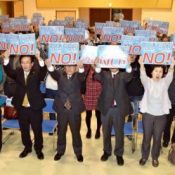
December 14, 2017 Ryukyu Shimpo
On December 13 at the Miyakojima City Central Public Hall on Miyako Island, a citizens’ rally was held to protest the construction of Japan Ground Self-Defense Force (GSDF) missile bases.
About 130 residents participated.
At the rally, participants approved a resolution in protest of the continuing construction of the GSDF bases, the plan to deploy to Ishigaki Island, and militarization of the Ryukyuan Islands.
They raised placards and their voices saying, “No New Bases on Miyakojima!”
The resolution said, “We will strongly condemn and object to the Ministry of Defense for disregarding the residents’ lives and forcing through construction, as well as Mayor Toshihiko Shimoji for selling this island.”
A member of the rally committee, Kunihiro Kishimoto, said, “Although the Ministry of Defense says the bases are deterrents, this deterrence is like the ‘ghosts’ used when fooling children.
It does not mean that other countries will believe in ghosts and not attack the bases.
The deterrent is a lie.
(English translation by T&CT and Megumi Chibana)
Go to Japanese
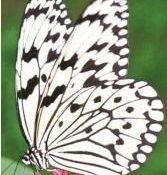
December 17, 2017 Ryukyu Shimpo
The “Haberu General Election,” (Hosted by the Okinawa Butterfly Designation Committee, Ryukyu Shimpo Co. Ltd., and co-hosted by the Youshinkai healthcare corporation), which was held to designate a prefectural butterfly as the symbol of nature conservation and biodiversity, tallied the final vote count on December 16.
Out of the 23,840 votes cast for one of Okinawa’s five representative butterflies, the tree nymph butterfly took the top spot with a near-majority tally of 11,440 votes.
Coming in at spots 2-5 were (in order): the Ceylon blue glassy tiger, the great nawab, the orange oakleaf, and great orange tip butterflies.
(English translation by T&CT and Sam Grieb)
Go to Japanese
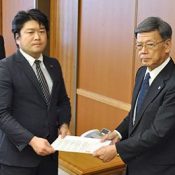
December 14, 2017 Ryukyu Shimpo
Following the accident in which a window frame fell off a U.S. helicopter and the grounds of Futenma Daini Elementary School in Ginowan City, on the afternoon of December 14, Governor Takeshi Onaga visited Minister of Defense Tomohiro Yamamoto. Governor Onaga went over the series of crashes and accidents of U.S. military aircrafts in the last year and directly appealed to the Minister to suspend flights for all U.S. military aircrafts at all Okinawa U.S. military bases. Governor Onaga pointed out that it is a “huge shock to the Okinawan citizens.” Minister Yamamoto was unable to give a clear response.
Regarding Okinawa’s request to suspend flights of all U.S. military aircrafts, Minister Yamamoto criticized the situation by saying, “I don’t understand what kind of logic this follows.” He then explained that he “did not understand the question.”
(English translation by T&CT and Chelsea Ashimine)
Go to Japanese
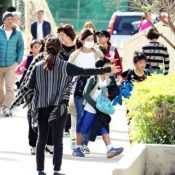
December 14, 2017 Ryukyu Shimpo
On December 13, an object reflecting white light was visible falling from the sky.
With a crashing sound a cloud of dust whirled about and U.S. military helicopter fragments flew into the air.
A window from this aircraft slammed down right in the center of Futenma Daini Elementary School’s sports field in Ginowan City, Okinawa.
The point where the window fell was ten meters from the nearest child.
Pupils were shocked and afraid, and their parents and guardians are adamant that they do not want aircraft flying in the sky above the school.
This occurred during second period, in the middle of the school day a bit past 10:00 a.m. when second-year and fourth-year pupils are engaging in physical education.
The second-years were playing ball, the fourth-year boys were jumping rope, and the fourth-year girls were practicing horizontal bar exercises.
Since the field was divided in half to keep the second- and fourth-year pupils separate, the middle of the field was not being used.
One of the school’s office staff who was on the second floor said that the sound of the aircraft was different from normal, expressed a sense of unease upon hearing it, and went to a window to look out.
For a moment there was white light reflecting off an object in the air.
A fourth-year boy was hit in the arm with some fine dirt thrown up from the impact, and went to the school infirmary.
Once the children took refuge inside the school building, some burst into tears recalling what had just happened.
Okinawan Prefectural Police restricted access to the school. A somber feeling hung heavy in the air as a CH-53E helicopter, the same type of craft as the one that had just crashed, flew around above the school.
Afternoon classes were cancelled under the circumstances, and the parents and guardians were informed to come pick up the children.
Parents and guardians arrived with grim expressions, and most left hurriedly.
The grandmother of one fourth-year female pupil who was in the schoolyard came to pick her up right when the crash occurred, and left with a stiff countenance.
A 9-year-old third-year pupil said as he left through the school gates: “There was suddenly an announcement broadcast to those of us in the classrooms.
It said that an aircraft part fell onto the sports field, and that we weren’t allowed to go outside even for break. It’s scary.
I wish the U.S. military would be a little more considerate of Okinawa’s kids.
There have been [U.S. military aircraft] accidents before, too, and I really want them to stop already.”
Around 3:00 p.m. some children in the vicinity of the school gathered together and unanimously commented that, “Today was the worst,” and “It was a real crisis.”
However, they said their teacher had instructed them not to talk about it except for with their families, and did not speak about the event any further.
(English translation by T&CT and Erin Jones)
Go to Japanese
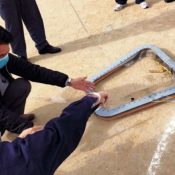
December 14, 2017 Ryukyu Shimpo
A window from a CH-53 helicopter flying out of MCAS Futenma, measuring 90 sq. cm. and 7.7 kg, landed on the sports ground of Futenma Second Elementary School in Ginowan just after 10 a.m. on December 13.
The window landed about 10 meters from a P.E. class comprising around 60 2nd and 4th-grade students.
One student complained of arm pain from debris kicked up by the window, but there were no apparent injuries.
In protest of the U.S. forces stationed in Okinawa, the Prefectural government demanded that all U.S. military flights be suspended until the cause of the drop is determined and safety confirmed.
In addition, Okinawa demanded to the Japanese federal government that the cessation of operations at the Futenma Airfield, scheduled to happen within the next five years, be accelerated.
With CH-53 accidents happening one after another, it was inevitable that there would be backlash from the people of Okinawa.
Since Okinawa’s reversion to Japan in 1971, there have been 69 incidents of parts falling from American military vehicles, including the incident at Midorigaoka Nursery School on December 7.
The window appears to be acrylic with a metal frame.
The Ginowan police investigated the scene and collected the window.
They are continuing to investigate if there is a case for charges such as injury due to negligence.
Brigadier General Paul J. Rock Jr., commanding General of Marine Corps Installations Pacific, gave his apology at the Okinawa Prefectural Office after hearing their protests, and indicated that, “All CH-53 helicopters were grounded [after the incident] and are currently not flying, but would not confirm that all flights would be suspended per the Okinawan government’s demand.
Governor Takeshi Onaga, Okinawa policy co-ordination director Katsuhiro Yoshida, and Ginowan Mayor Atsushi Sakima each visited the scene of the incident on December 13 after hearing the news.
Governor Onaga traveled to Tokyo on the 14th to protest to the federal government.
Futenma Second Elementary School Principal Etsuko Kyan also demanded to Okinawa Defense Bureau (ODB) chief Koichiro Nakajima that there be no flights over the school.
Kyan told reporters, “We will not be able to use the sports ground until we have confirmation that there will be no flights overhead.”
The Okinawan Police have asked the military to inspect the helicopter from which the window dropped as well as question the passengers, but there has not been a response from the military as of yet.
Minister of Defense Itsunori Onodera indicated at a press conference December 13 at Haneda Airport his intention to request that the U.S. military voluntarily restrict flights.
ODB chief Nakajima has also requested that flights stop.
According to the Ministry of Defense, the window was from the left side of the cockpit.
The window fell as the helicopter passed over the school just after takeoff. The helicopter returned to base shortly thereafter.
Okinawa vice-governor Moritake Tomikawa handed out letters of protest the afternoon on December 13 at the prefectural office to Tsukasa Kawada, Ambassador in charge of Okinawan Affairs; Brigadier General Rock; and Joel Ehrendreich, Consul General at the U.S. Consulate in Naha.
(English translation by T&CT and Sam Grieb)
Go to Japanese

December 7, 2017 Ryukyu Shimpo
On December 6, four young men on probation for vandalizing the natural cave Chibichirigama visited the cave with their guardians and probation officers.
Chibichirigama, in Namihira, Yomitan, Okinawa Prefecture was the site of “collective suicide” (collective forced death) by civilians during the Battle of Okinawa.
The young men visited the cave and apologized to the families of those who died there.
Norio Yonaha, head of the Bereaved Families Association, responded to the Ryukyu Shimpo’s interview by saying, “The young men will always live with the weight of their crime, but we at the Bereaved Families Association want to support them until they come of age so that they can return to society.
First and foremost, I want them to learn about Chibichirigama.”
According to Mr. Yonaha, each of the young men apologized, and they then placed paper cranes and flowers on the ossuary and put their hands together to pay tribute to the deceased.
The young men told the families that they would not do anything to hurt them again in the future and said that they wanted to study the Battle of Okinawa so they can teach their own children about it in the future.
One of the young men also delivered a letter containing words of apology.
The young men plan to work together with Minoru Kinjo, creator of the “Statue of Peace Connecting Generations” at the entrance to the cave, to repair the statue, and will also clean up the area around the cave.
Because the young men vandalized Chibichirigama as a prank without knowing the history of the cave, the families asked them to study Chibichirigama using materials and books, and to compile a report on what they learned.
In September, the young men pulled apart the strings of paper cranes inside the cave and destroyed mementos and signboards.
They were arrested for damaging physical articles and put on probation.
(English translation by T&CT and Sandi Aritza)
Go to Japanese
December 12, 2017 Ryukyu Shimpo Digital Edition
In connection to the fall of a U.S. military helicopter part on the roof of Midorigaoka Nursery School in Nodake, Ginowan, the nursery school parents’ association visited Vice Governor Moritake Tomikawa at the Prefectural Office on the afternoon of December 12 and requested that the prefectural government urge the Japanese and U.S. governments to cease flights until the cause of the accident is uncovered and to stop U.S. military helicopter flights over nursery schools.
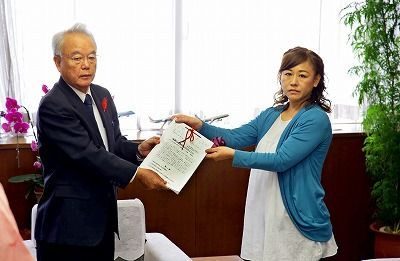
After U.S. military aircraft part falls on nursery school, a representative of Midorigaoka Nursery School (right) presents a written petition to Vice Governor Tomikawa at 12:43 p.m. on December 12 at the vice governor’s reception room at the Prefectural Office (photograph by Daisuke Nakagawa)
The parents said that the problem is not whether the particular aircraft part fell in this instance, but that such problems would not occur to begin with if aircraft didn’t pass over the school, and said that they just want their children to be able to live normal lives and be able to play outside without incident.
The vice governor read a document with parents’ comments that was attached to the petition and said, “I can clearly see that the children are experiencing great fear and have suffered psychological trauma.
The prefectural government hopes to do our best to respond to your request that flights over the nursery school be stopped.”
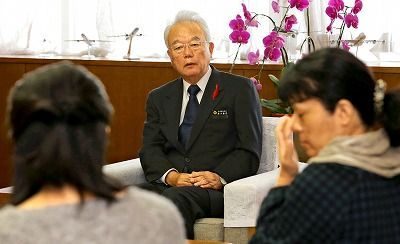
Members of the nursery school parents’ association make a tearful plea to Vice Governor Tomikawa to uncover the cause of the accident in which a U.S. military helicopter part appeared to fall on a nursery school at 12:52 p.m. on December 12 at the vice governor’s reception room at the Prefectural Office (photograph by Daisuke Nakagawa)
A mother living in Aragusuku, Ginowan said she was surprised when her one-year-old daughter, who attends the nursery school, said, “Mama, it’s ‘boom boom!’” when a U.S. military aircraft flew over their house.
The petition presented to Vice Governor Tomikawa explained that it was a shock to think that the incident remained fresh in the memory of even a one-year-old child who could not yet even speak.
(English translation by T&CT and Sandi Aritza)
Go to Japanese
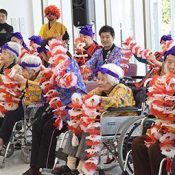
December 8, 2017 Ryukyu Shimpo
A performance group named GGB (Gushikawa Koseien Gichan & Bachan), made their debut at the Uruma City Office December 6.
The group, which has an average age of 80, was launched with members at the Gushikawa Koseien social welfare facility for the elderly this April.
Twenty members from 65 to 102 years old performed during the first performance held outside of the facility.
The audience who gathered at the venue waved their handmade shiny fans and sung folk songs together, ending the show on a high note.
The group is modled after an idol group in Kohama Island called Kohama Island Bachan Choir Group, also known as KBG 84.
Gushikawa Koseien members raised their voices saying, “we can do better,” and formed a performance group with those who practice folk songs and a castanet-like Okinawan instrument called Yotsudake once a week.
They named the group as GGB Performing Group and plan to host one performance per year.
Kazuko Yamada, who is 102 years-old and the senior member of the group, performed in the center spot.
She began dancing before the music was played, and she got the audience’s hearty laughter when she was asked if she had a fun and jokingly responded, “Maybe, I don’t know.”
(English translation by T&CT and Sayaka Sakuma)
Go to Japanese
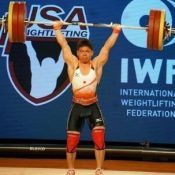
December 1, 2017 Ryukyu Shimpo
Day two of the World Weightlifting Championships was held on November 29 in Anaheim, CA. Yoichi Itokazu 26, who placed fourth at the Rio de Janeiro Olympics in the 62 kg class last year, won a silver medal in the total 299 kg category, the snatch 134 kg class and the jerk 165 kg class.
Itokazu is from Okinawa and currently affiliated with the Metropolitan Police Department after graduating from Tomishiro High School and Nihon University.
According to the Japan Weightlifting Association, it has been 36 years since a the last Japanese athlete medaled at a world championship in 1981.
Those involved in weight-lifting in Okinawa applaud Itokazu for winning a silver medal, commenting that, “ranking second in the world has significant meaning,” and, “getting a medal is such an accomplishment.”
Some share high expectations for the upcoming Olympic Games with the Japanese weight-lifter winning a medal for the first time in 36 years, saying, “He is going to be a salvation for Japan in the 2020 Tokyo Olympics.”
Asatami Owan from Itoman City, an adviser for the Okinawa Weightlifting Association who has instructed Itokazu since he was in Kudaka Jr. High School and Tomishiro High School, told Itokazu “there is no meaning if there is no medals” to encourage him.
Owan commented, “Itokazu seemed to be relieved after he achieved a new record for Japan during the Rio Olympics.
Since having a strategy is crucial to gain medals, I encouraged him to refresh his mind and aim for medals. I’m glad that he performed as expected.”
Masahiro Kinjo, who currently teaches at the Miyuki Jr. High School in Ishikawa Prefecture, coached Itokazu during his second and third year at Tomishiro High School.
Kinjo praised his former student saying, “It was frustrating when he missed the chance to compete at the London Olympics, but he stood up in the face of adversity and ranked fourth at the Rio Olympics as well as second at the World Championships.
He is an athlete who can use frustration as an impetus to overcome hardships.”
Tsutomu Kawabata, the president of the Okinawa Weightlifting Association, watched the competition streaming online.
He was pleased with Itokazu’s performance in the big championship, commenting, “I’m really happy.
This proves how he continues training everyday.
It’s also inspiring for those of us who are involved in weightlifting.”
Senior athletes who competed at previous Olympic Games and World Championships were also excited about Itokazu receiving the silver medal.
Choji Taira, vice-president of the weightlifting association who ranked twelveth in the 1983 World Championships in the male 67.5 kg class and fifth at the 1984 Los Angeles Olympics, applauded Itokazu’s good performance.
He shares his expectation for Itokazu commenting that “Itokazu is a humble person, and his diligent efforts led to this result.
I hope he will strategically plan his training for the upcoming Tokyo Olympics.”
Hisaya Yoshimoto, currently working at Higashi Village Office, competed in two consecutive Olympic Games: the 1996 Atlanta Olympics and the 2000 Sydney Olympics. Yoshimoto also competed in the 1997 World Championships where he ranked fifth in the 108kg class.
He emphasized the significance of Itokazu’s accomplishment saying, “This medal means a lot.
He will be a savior for Japanese male athletes and influence other athletes too.”
Mari Taira, currently teaching at Okinawa Technical High School and who ranked seventh at the Sydney Olympic Games and fifth at the 1999 World Championships in the female 53kg class, excitedly commented that, “This is really a great accomplishment.
He grew as a national and international weight-lifter from Okinawa.
It’s a profound event. I think this is benchmark moment for him, and I hope that he will continue to develop more for the Tokyo Olympics.”
(English translation by T&CT and Sayaka Sakuma)
Go to Japanese
December 11, 2017 Ryukyu Shimpo
By Ryota Shimabukuro
In the decade spanning 2007 through 2016, the average indictment rate for people associated with the U.S. military (including military personnel, military contractors, and family members) who committed general criminal offenses (criminal offenses excluding vehicular manslaughter due to negligence) in Japan was 17.5 percent.
Calculating from all domestic crime of this type in Japan over the same period including Japanese persons, the results showed that the average indictment rate was still under half at 41.17 percent.
Ryukyu Shimpo compiled statistics from Ministry of Justice documents obtained through freedom of information requests.
It has been confirmed that in 1953 the U.S. and Japanese governments made a secret agreement in which Japan established it will not exercise its right to primary jurisdiction over cases of criminal activity by people associated with the U.S. military, with the exception of incidents judged to be highly significant for Japan.
Over more than 60 years to the present day the effects of this secret agreement continue, brought to light by the fact that most U.S. military-related offenses are processed without the culprits facing any criminal liability.
Out of 33 incidents of rape by people associated with the U.S. military between 2007 and 2016, only one case led to indictment, meaning the indictment rate of rape incidents was only 3 percent.
In comparison with the most recent official report of all domestic rape cases between 2005 and 2014, the average indictment rate was much higher at 46.92 percent.
The Ministry of Justice is compiling a report on criminal incidents caused by U.S. servicemen and other associated persons in addition to its annual official white paper on crime.
Numbers for the 2017 version of the white paper, announced at the cabinet meeting on November 17, have undergone initial calculations.
According to the white paper on crime, between 2007 and 2016 the indictment rate on cases of rape or attempted rape resulting in death or injury were only 30 percent.
Seven cases did not lead to indictment, while three did. The indictment rate for robbery was 23 percent; ten cases did not result in indictment, and three did.
However, between 2007 and 2016 robberies resulting in fatalities had a high indictment rate of 77 percent; ten cases lead to indictment and 3 did not.
Murders committed over the same period had a high indictment rate at 75 percent; three cases were indicted and one was not.
The U.S.-Japan Joint Committee’s Criminal Jurisdiction Subcommittee verified the secret agreement of October 28, 1953.
In 2008 the existence of the record of these proceedings became public.
(English translation by T&CT and Erin Jones)
Go to Japanese











 Webcam(Kokusai Street)
Webcam(Kokusai Street)


